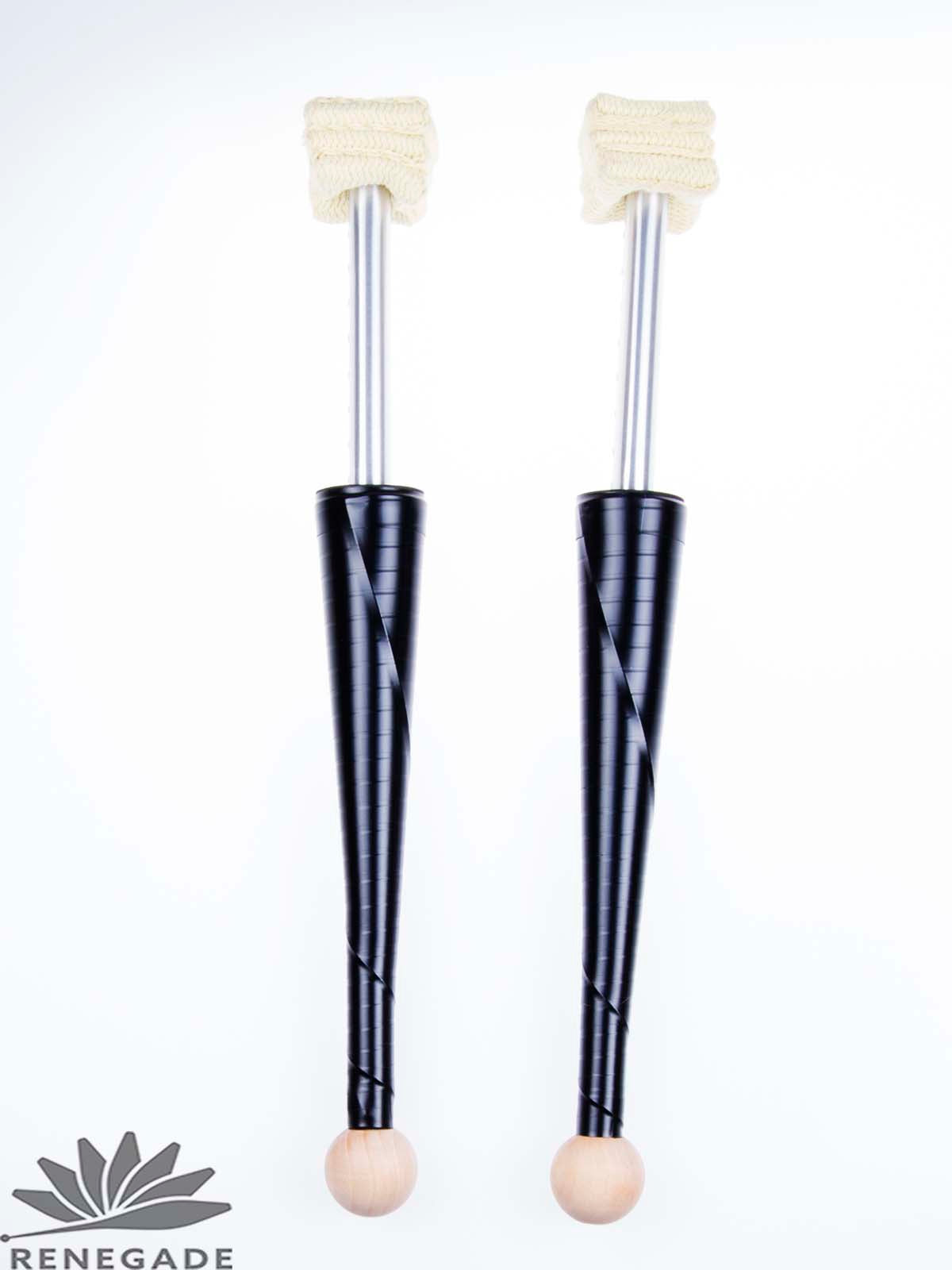Swinging Torch
Care & Maintenance <br />
<br />
Renegade Swinging torches are designed specifically <br />
for club swinging and are not intended to be <br />
thrown/juggled. In order to keep your torches in good <br />
condition it is very important that you follow our <br />
recommended instructions for proper use and safety. <br />
<br />
Fuels <br />
<br />
There are many types fuels that can be <br />
used on the torches. The best in regards to <br />
safety and getting the maximum life span <br />
out of your swinging torches is to use lamp <br />
oil (kerosene, paraffin or charcoal lighter). <br />
This type of fuel is not explosively volatile <br />
like white gas (Coleman Fuel, camp stove <br />
fuel), and it burns at a much lower temperature. <br />
Many jugglers prefer white gas, as it <br />
produces a brighter flame, and lights very <br />
quickly. It is much more dangerous that <br />
lamp oil and can reduces the live span ofv
your torches. <br />
<br />
Equipment Use and
Techniques <br />
<br />
You can either dip the torches in a <br />
container of fuel or squirt on the fuel, (a <br />
plastic charcoal lighter fluid bottle works <br />
good). After applying the fuel be sure to <br />
shake out any excess fuel from your torch <br />
wicks before lighting them. If you do not, <br />
the torches will spray little fire droplets off <br />
the wicks as you swing them. Shaking off <br />
the excess fuel, is also important, so that the <br />
fuel does not run down the metal sleeve and <br />
onto the rubber gasket/handle <br />
The rubber gasket/handle in not fire <br />
proof and must be kept away from prolonged <br />
contact with the flames from the <br />
wick head or another torch. Fire may come <br />
into contact with this rubber gasket, when a <br />
torch is held in a downward orientation or <br />
when several torches are held in one hand. <br />
If the rubber gasket gets too hot it can melt <br />
or in extreme cases catch on fire. If this <br />
happens blow out the torch and let it cool <br />
before relighting it. Always hold your <br />
torches upright, when not spinning. Never <br />
leave the torch on the ground while burning. <br />
You will increase the life span of the <br />
wick if you always extinguish the torch <br />
before the flame dies out. This is because <br />
you will burn the wick material after all the <br />
fuel is used up. Let your torches cool off for <br />
several minutes before refueling and lighting <br />
again. <br />
<br />
Safety <br />
<br />
Obviously this is where a lot of common <br />
sense plays in. The surface you are <br />
swinging on should not be flammable, (dry <br />
grass, carpet or such). You should not be <br />
wearing highly flammable costumes or <br />
loose polyester clothing that can easily <br />
catch on fire. The best clothing to wear is <br />
tight fitting 100% thick cotton or leather. <br />
Pay particular attention to what you do <br />
with your fuel container after you have <br />
fueled up your torches. Never leave fuel <br />
containers open, a dropped torch can knock <br />
over the container and start a fire. Always <br />
store your fuel in an appropriate container, <br />
which is made for fuel storage. <br />
Always have a spotter watching you <br />
swinging fire who is paying attention and is <br />
ready to respond to an accidental fire. They <br />
should have a damp 100% cotton towel (fire <br />
blanket) on hand to put out any small fires <br />
that might occur. This damp towel is also a <br />
good way to put out the torches if the flame <br />
is too large to blow out. It is prudent to <br />
rehearse safety routines and to have a code <br />
word like ?STOP? in case the person is on <br />
fire themselves so that the spotter can reach <br />
the performer without getting hit by <br />
swinging torch. When performing swinging <br />
torches you should also have a CO2 fire <br />
extinguisher on hand in case of fire. <br />
Inspect your swinging torches regularly <br />
for any signs of wear or failure. Do not use <br />
fire equipment that looks damaged or is in <br />
poor repair. Make sure the wick and knob is <br />
securely fastened and is not loose. <br />
<br />
Replacement wicks <br />
<br />
Replacement wicks and other repair <br />
parts may be purchase directly from our <br />
website at www.renegadejuggling.com. You <br />
will need (2) 18 inches of 2" X 1/8" which <br />
you braid together to make the cube shape, <br />
tuck the last pieces into the braid so you do <br />
not have any loose ends. You can also order <br />
the wick already made into the cube shape <br />
from our website, if you prefer. Make sure <br />
that when you replace the screw that the <br />
dowel is not to burned out to securely hold <br />
the screw into place. <br />
<br />
Storage and Transportation <br />
<br />
Torches should be stored in a metal <br />
container, tool box or other fire proof can. <br />
The torch wick may contain unburned fuel <br />
that remains flammable. The stored torches <br />
should not come in contact with high heat of <br />
sparks. Many commercial airlines will no <br />
longer allow torches in checked bags that <br />
have residue fuel on them. When flying it <br />
may be possible that they will not be allowed <br />
on the plane if you bag is inspected <br />
and they can see the torches. <br />
<br />

